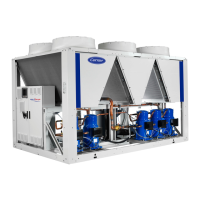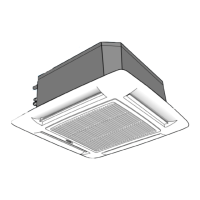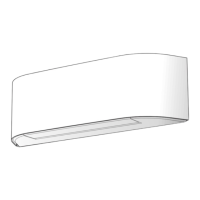32
The piping between the 30WGA and the condenser must be
correctly supported in line with its size and the operating
weight. Piping support is required to ensure that vibration
levels at the piping are lower than the values at the compressor.
If resonance occurs, reduce the width between the collar until
the vibration levels are acceptable.
8 - PIPE SIZING WITH REFRIGERANT FOR 30WGA UNITS
8.1 - General considerations and pipe size limits
Pipe size limits
30WGA Maximum
Linear length (discharge - liquid line) 30m
Height difference 12 m
The pipes must be as short as possible and have the least
possible changes (bends etc.) to minimise pressure drops. If
there is a risk of poor piping use, adequate measures must be
taken (design, positioning, protection) to prevent incorrect
use.
The following constraints must be taken into account whe
the refrigerant pipes are sized:
• Oil return to the compressor is ensured by entrainment.
A minimum refrigerant velocity is required to ensure
entrainment. This velocity depends on the pipe diameter,
the refrigerant and oil temperature (these are treated
as being the same in most cases). A reduction of the
pipe diameter permits an increase of the refrigerant
velocity. The problem of a minimum entrainment
velocity does not exist for the pipes that carry liquid
refrigerant as the oil is fully miscible here.
• The pressure drop at the compressor discharge (pipes
linking the compressor outlet to the condenser inlet)
must be limited to avoid system performance losses
(increased compressor power input and decreased
cooling capacity). Increasing the pipe diameter permits
limiting the pressure drops.
• The pressure drop in the liquid line (linking the condenser
outlet to the expansion device) must not result in a
change of phase. The estimate of these pressure drops
must include those generated by possible accessories
such as solenoid valves and lter driers.
• In applications with low outside temperature and with
long pipes use of a check valve at the condenser outlet
is recommended to overcome the poor supply of the
expansion device during the start-up phase. Select a
valve that is not pressure-tight to avoid signicant
pressure rises of the liquid refrigerant that may be trapped
between the solenoid valve (tight) and the check valve.
8.2 - Pipe sizing
The following procedure can be used for pipe sizing:
1. Measure the length (in metres) of the piping under
consideration.
2. Add 50% to take account of special characteristics.
3. Read the pipe size from tables 1 and 2 below.
4. Calculate the equivalent lengths for parts included in
the piping under consideration (such as valves, lters,
connections). The equivalent lengths are normally
available from the component supplier. Add these lengths
to the length calculated above.
5. Repeat steps 3 and 4 if necessary.
6. See tables “Discharge line piping” and “Liquid line
piping” below.
8.3 - Discharge pipe sizing
The discharge piping must be sized to achieve reasonable
pressure drops: a variation of 1.5 K of the saturated tempe-
rature is normally accepted (approx. 90 kPa variation for a
condensing temperature of 45 °C).
Table 1 - Discharge line piping*
30WGA 020 025 030 035 040 045 050 060 070 080 090
Equivalent length
0-10 m in 3/4 3/4 7/8 7/8 7/8 7/8 1-1/8 1-1/8 1-1/8 1-1/8 1-1/8
10-20 m in 7/8 7/8 7/8 1-1/8 1-1/8 1-1/8 1-1/8 1-1/8 1-3/8 1-3/8 1-3/8
20-30 m in 7/8 1-1/8 1-1/8 1-1/8 1-1/8 1-1/8 1-3/8 1-3/8 1-3/8 1-3/8 1-3/8
30-40 m in 1-1/8 1-1/8 1-1/8 1-1/8 1-1/8 1-1/8 1-3/8 1-3/8 1-3/8 1-3/8 1-5/8
40- 50 m in 1-1/8 1-1/8 1-1/8 1-1/8 1-3/8 1-3/8 1-3/8 1-3/8 1-3/8 1-3/8 1-5/8
50-60 m in 1-1/8 1-1/8 1-1/8 1-1/8 1-3/8 1-3/8 1-3/8 1-3/8 1-3/8 1-3/8 1-5/8
60-70 m in 1-1/8 1-1/8 1-1/8 1-3/8 1-3/8 1-3/8 1-3/8 1-3/8 1-3/8 1-3/8 1-5/8
70 m or more in 1-1/8 1-1/8 1-1/8 1-3/8 1-3/8 1-3/8 1-3/8 1-3/8 1-3/8 1-3/8 1-5/8
* Recommendeddiameterstoensureoilreturnintheapplicationrange.
Table 2 - Liquid line piping*
30WGA 020 025 030 035 040 045 050 060 070 080 090
Equivalent length
0-10 m in 1/2 1/2 1/2 1/2 1/2 1/2 1/2 5/8 5/8 5/8 5/8
10-20 m in 1/2 1/2 1/2 1/2 5/8 5/8 5/8 5/8 5/8 3/4 3/4
20-30 m in 1/2 1/2 1/2 5/8 5/8 5/8 5/8 5/8 3/4 3/4 3/4
30-40 m in 1/2 5/8 5/8 5/8 5/8 5/8 3/4 3/4 3/4 3/4 3/4
40- 50 m in 5/8 5/8 5/8 5/8 5/8 5/8 3/4 3/4 3/4 3/4 7/8
50-60 m in 5/8 5/8 5/8 5/8 5/8 3/4 3/4 3/4 3/4 7/8 7/8
60 m or more in 5/8 5/8 5/8 5/8 3/4 3/4 3/4 3/4 7/8 7/8 7/8
* Recommendeddiameterstolimittheimpactofthe1.5Kpressureloss.

